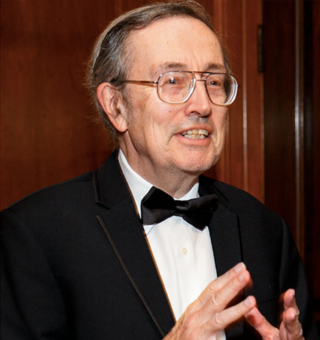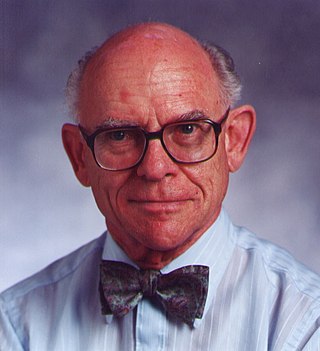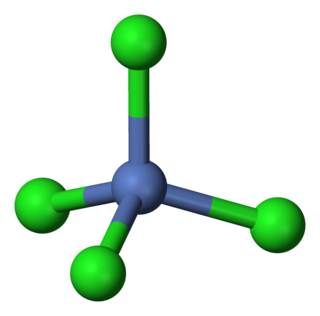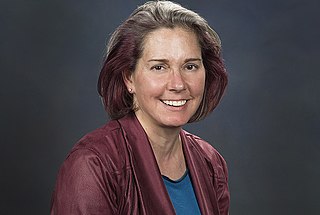
Henry Taube, was a Canadian-born American chemist who was awarded the 1983 Nobel Prize in Chemistry for "his work in the mechanisms of electron-transfer reactions, especially in metal complexes." He was the second Canadian-born chemist to win the Nobel Prize, and remains the only Saskatchewanian-born Nobel laureate. Taube completed his undergraduate and master's degrees at the University of Saskatchewan, and his PhD from the University of California, Berkeley. After finishing graduate school, Taube worked at Cornell University, the University of Chicago and Stanford University.

Robert Howard Crabtree is a British-American chemist. He is serving as Conkey P. Whitehead Professor Emeritus of Chemistry at Yale University in the United States. He is a naturalized citizen of the United States. Crabtree is particularly known for his work on "Crabtree's catalyst" for hydrogenations, and his textbook on organometallic chemistry.

Malcolm Leslie Hodder Green was Professor of Inorganic Chemistry at the University of Oxford. He made many contributions to organometallic chemistry.

Frank Albert Cotton FRS was an American chemist. He was the W.T. Doherty-Welch Foundation Chair and Distinguished Professor of Chemistry at Texas A&M University. He authored over 1600 scientific articles. Cotton was recognized for his research on the chemistry of the transition metals.

Stephen James Lippard is the Arthur Amos Noyes Emeritus Professor of Chemistry at the Massachusetts Institute of Technology. He is considered one of the founders of bioinorganic chemistry, studying the interactions of nonliving substances such as metals with biological systems. He is also considered a founder of metalloneurochemistry, the study of metal ions and their effects in the brain and nervous system. He has done pioneering work in understanding protein structure and synthesis, the enzymatic functions of methane monooxygenase (MMO), and the mechanisms of cisplatin anticancer drugs. His work has applications for the treatment of cancer, for bioremediation of the environment, and for the development of synthetic methanol-based fuels.
Nickel(II) nitrite is an inorganic compound with the chemical formula Ni(NO2)2. Anhydrous nickel nitrite was first discovered in 1961 by Cyril Clifford Addison, who allowed gaseous nickel tetracarbonyl to react with dinitrogen tetroxide, yielding a green smoke. Nickel nitrite was the second transition element anhydrous nitrite discovered after silver nitrite.

Abhik Ghosh is an Indian inorganic chemist and materials scientist and a professor of chemistry at UiT – The Arctic University of Norway in Tromsø, Norway.

Tetrachloronickelate is the metal complex with the formula [NiCl4]2−. Salts of the complex are available with a variety of cations, but a common one is tetraethylammonium.
The tetrabromonickelate anion contains a doubly-charged nickel atom (Ni2+) surrounded by four bromide ions in a tetrahedral arrangement. The formula is [NiBr4]2−.

Jaqueline Kiplinger is an American inorganic chemist who specializes in organometallic actinide chemistry. Over the course of her career, she has done extensive work with fluorocarbons and actinides. She is currently a Fellow of the Materials Synthesis and Integrated Devices group in the Materials Physics and Applications Division of Los Alamos National Laboratory (LANL). Her current research interests are focused on the development of chemistry for the United States’ national defense and energy needs.
Christopher "Kit" Colin Cummins is an American chemist, currently the Henry Dreyfus Professor at the Massachusetts Institute of Technology. He has made contributions to the coordination chemistry of transition metal nitrides, phosphides, and carbides.
Lawrence Que Jr. is a chemist who specializes in bioinorganic chemistry and is a Regents Professor at the University of Minnesota, Twin Cities. He received the 2017 American Chemical Society (ACS) Award in Inorganic Chemistry for his contributions to the field., and the 2008 ACS Alfred Bader Award in Bioinorganic Chemistry.

Transition metal nitrile complexes are coordination compounds containing nitrile ligands. Because nitriles are weakly basic, the nitrile ligands in these complexes are often labile.
Mary Rakowski DuBois is an inorganic chemist, now retired from Pacific Northwest National Laboratory (PNNL). She made multiple contributions to inorganic and organometallic chemistry, focusing on synthetic and mechanistic studies. In recognition of her scientific contributions, she received several awards.
Karsten Meyer is a German inorganic chemist and Chair of Inorganic and General Chemistry at the Friedrich-Alexander University of Erlangen-Nürnberg (FAU). His research involves the coordination chemistry of transition metals as well as uranium coordination chemistry, small molecule activation with these coordination complexes, and the synthesis of new chelating ligands. He is the 2017 recipient of the Elhuyar-Goldschmidt Award of the Spanish Royal Society of Chemistry, the Ludwig-Mond Award of the Royal Society of Chemistry, and the L.A. Chugaev Commemorative Medal of the Russian Academy of Sciences, among other awards. He also serves as an Associate Editor of the journal Organometallics since 2014.

1,1,1-Tris(diphenylphosphinomethyl)ethane, also called Triphos, is an organophosphorus compound with the formula CH3C[CH2PPh2]3. An air-sensitive white solid, it is a tripodal ligand ("three-legged") of idealized C3v symmetry. It was originally prepared by the reaction of sodium diphenylphosphide and CH3C(CH2Cl)3:
Suzanne Cathleen Bart an American chemist who is a professor of inorganic chemistry at Purdue University. Her group's research focuses on actinide organometallic chemistry, and especially the characterization of low-valent organouranium complexes, actinide complexes with redox-active ligands, and discovery of new reactions that utilize these compounds. Bart's research has applications in the development of carbon-neutral fuel sources and the remediation of polluted sites.

Martin Albrecht is a Swiss chemist. He is Professor of Inorganic Chemistry at the Department of Chemistry, Biochemistry and Pharmacy at the University of Bern. He is known for his contribution to carbene chemistry, particularly with his work on 1,2,3-triazolylidene mesoionic carbene.
Ivano Bertini was an Italian chemist recognized for his significant contributions in the field of bioinorganic chemistry, particularly in NMR spectroscopy of metalloproteins.

Fausto Calderazzo was an Italian inorganic chemist. He gained renown from numerous contributions in inorganic chemistry and organometallic chemistry. Hr was born in Parma, on March 8, 1930, where his father served in the Royal Italian army. He died in Pisa on June 1, 2014, at the age of 84.












